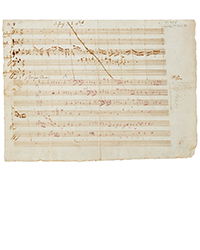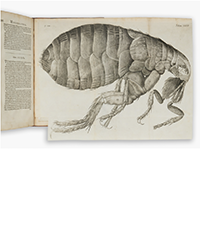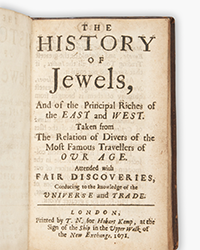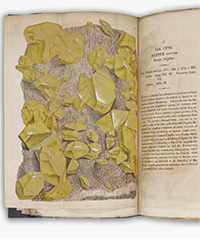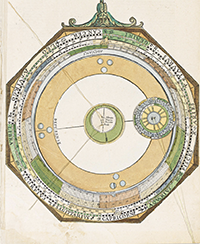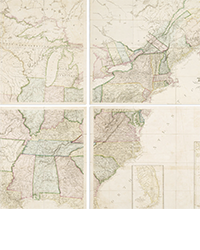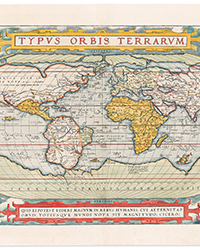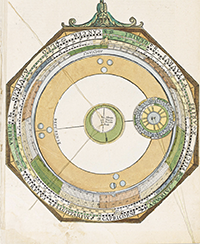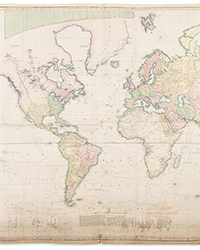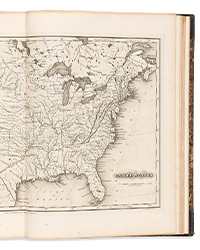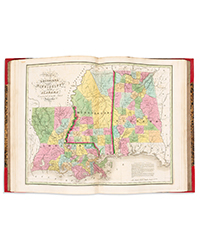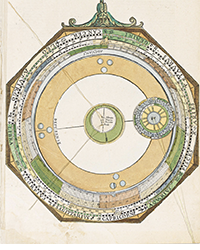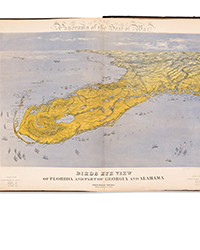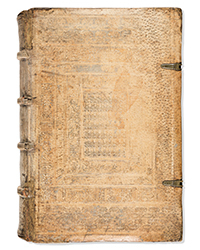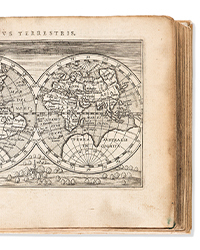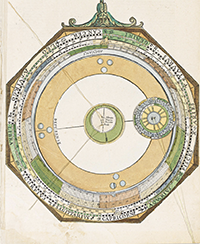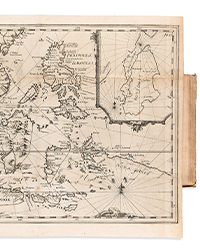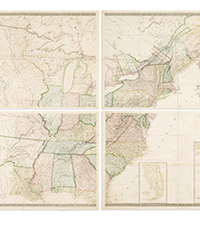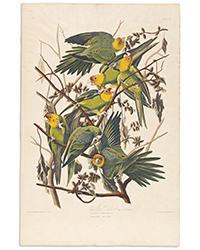Mysteries surrounding old books are little devils dedicated to tormenting us. One of them has been nagging me for a while. It emanates from a particular book (Choix d’anecdotes Américaines..., Paris) with an anachronistic title page. That’s anecdotal, of course. But you know—those little devils will drive you mad.
This is an anonymous book from the late 18th century entitled Choix d’anecdotes américaines... It is a chronological history of the New World compiled from authoritative authors like Solis, Herrera etc. My copy was apparently printed in Paris, where it was available at “all booksellers’”—which is unusual. There’s no date of printing either. To tell you the truth, there’s something fishy about this title page. Actually, it doesn’t look like an 18th century title page, but rather like a 19th century one. I held it in front of my window, and it confirmed that it was printed on laid paper—so, possibly from the 18th century. But the bold letters used by the printer do not fit in—and there’s this sub-title, reading “depuis sa découverte” (since its discovery, referring to the New World). Depuis Sa découverte? With a modern “s” instead of the obsolete “f ”? This orthographical sign disappeared at the end of the 18th century, not before. And a quick research confirmed that this book was printed in 1776. And that it was, according the record of a Catawiki sale listed on Rarebookhub.com, the “first and only edition”. While researching for the date of printing, I came across another copy of my book with the same anachronistic title page. But I also came across several other copies with a regular 18th century title page! The title itself is different, Anecdotes américaines... Plus, this other anachronistic copy comes, just like mine, with a later binding—early 19th century.
As the regular title page teaches us, Anecdotes américaines... was printed in 1776 by Philippe Vincent, a printer-bookseller located Rue des Mathurins, in Paris. He was the heir of Jacques Vincent (1671-1760), who retired in 1750 after he sold his printing house and his stock of books to his son Philippe. The sub-titles on regular copies are the same, but written as required: “depuis fa découverte”. And it mentions an “approbation and a privilege”. The rest of the book is strictly identical—same letters, same slight printing defects. It features 782 pages and it was part of a greater project that started with the success of Anecdotes françaises... (Paris, 1769). It came out anonymously but a description on Bibliorare states: “Barbier (178-179) attributes this book to Antoine Hornot.” Also known as Déjean (a nom de plume), Hornot is an obscure writer. Even the BNF website doesn’t know much about him: “The often anonymous author of various dictionaries or compilations of historical anecdotes.” Nonetheless, this is quite an entertaining book, and a cheap one if you’re fine with modest bindings.
This anachronistic title page must have been placed at the head of unsold 1776 copies at the turn of the 19th century. The BNF writes that Vincent “sold his printing house around March 30, 1779. Allegedly retired shortly afterwards. Died in Paris, April 1790.” The bookseller who bought the remaining stock probably had a new title page printed after the Révolution (1789). There was no need now to get a privilege, and the book could be sold at “all booksellers’”. Guess the printer thought that “Choix d’anecdotes américaines...” (Choice of anecdotes) was catchier than the original and simpler Anecdotes américaines... But who was he? My little research came to a dead end at this point. Have to admit that a lot of things are lost in the course of time. But sometimes, someone tries to build bridges. For instance, an anonymous reader added a moving note in my copy. He did it in the margin of the last anecdote from 1776: “On July 4, 1776, the United States proclaimed and declared their independence. These states formed a perpetual confederation on October 4, 1776. Great Britain recognized their independence in October 1782.” Just like the title page, this is a hard to date note—this is an old note, for sure. The writer writes the number “7” in an old-fashioned way (for a French, that is—he didn’t ad the transversal bar to it, just like the English do nowadays). He clearly used old dark ink with a feather. But—part of the note was originally written with a paper pencil, and then rewritten with ink. The modern version of paper pencils was invented around 1792-1795 in Europe. Unfortunately, there’s not a single sounding “s” in his note—impossible thus, to know if he was still using the obsolete ‘f’. So it could be a contemporary note. Or not, a little devil giggles.
From a dubious “s” to the invention of pencil paper, those little devils are really making fun of us. But is finding out about those details that frivolous? Maybe, especially since any little answer comes with ten more questions. But after all—and Hornot would probably agree—, isn’t the great history of mankind made of little anecdotes?
Thibault Ehrengardt


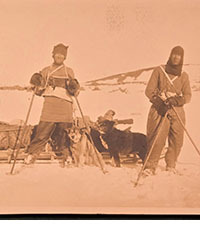
![<b>Scandinavian Art & Rare Books Auctions, Dec. 4:</b> ROALD AMUNDSEN: «Sydpolen» [ The South Pole] 1912. First edition in jackets and publisher's slip case. <b>Scandinavian Art & Rare Books Auctions, Dec. 4:</b> ROALD AMUNDSEN: «Sydpolen» [ The South Pole] 1912. First edition in jackets and publisher's slip case.](https://ae-files.s3.amazonaws.com/AdvertisementPhotos/0a99416d-9c0f-4fa3-afdd-7532ca8a2b2c.jpg)
![<b>Scandinavian Art & Rare Books Auctions, Dec. 4:</b> AMUNDSEN & NANSEN: «Fram over Polhavet» [Farthest North] 1897. AMUNDSEN's COPY! <b>Scandinavian Art & Rare Books Auctions, Dec. 4:</b> AMUNDSEN & NANSEN: «Fram over Polhavet» [Farthest North] 1897. AMUNDSEN's COPY!](https://ae-files.s3.amazonaws.com/AdvertisementPhotos/a077b4a5-0477-4c47-9847-0158cf045843.jpg)
![<b>Scandinavian Art & Rare Books Auctions, Dec. 4:</b> ERNEST SHACKLETON [ed.]: «Aurora Australis» 1908. First edition. The NORWAY COPY. <b>Scandinavian Art & Rare Books Auctions, Dec. 4:</b> ERNEST SHACKLETON [ed.]: «Aurora Australis» 1908. First edition. The NORWAY COPY.](https://ae-files.s3.amazonaws.com/AdvertisementPhotos/6363a735-e622-4d0a-852e-07cef58eccbe.jpg)
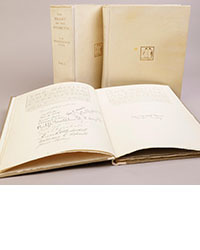
![<b>Scandinavian Art & Rare Books Auctions, Dec. 4:</b> SHACKLETON, BERNACCHI, CHERRY-GARRARD [ed.]: «The South Polar Times» I-III, 1902-1911. <b>Scandinavian Art & Rare Books Auctions, Dec. 4:</b> SHACKLETON, BERNACCHI, CHERRY-GARRARD [ed.]: «The South Polar Times» I-III, 1902-1911.](https://ae-files.s3.amazonaws.com/AdvertisementPhotos/3ee16d5b-a2ec-4c03-aeb6-aa3fcfec3a5e.jpg)
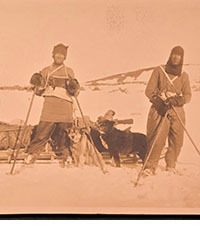
![<b>Scandinavian Art & Rare Books Auctions, Dec. 4:</b> [WILLEM BARENTSZ & HENRY HUDSON] - SAEGHMAN: «Verhael van de vier eerste schip-vaerden […]», 1663. <b>Scandinavian Art & Rare Books Auctions, Dec. 4:</b> [WILLEM BARENTSZ & HENRY HUDSON] - SAEGHMAN: «Verhael van de vier eerste schip-vaerden […]», 1663.](https://ae-files.s3.amazonaws.com/AdvertisementPhotos/d5f50485-7faa-423f-af0c-803b964dd2ba.jpg)
![<b>Scandinavian Art & Rare Books Auctions, Dec. 4:</b> TERRA NOVA EXPEDITION | LIEUTENANT HENRY ROBERTSON BOWERS: «At the South Pole.», Gelatin Silver Print. [10¾ x 15in. (27.2 x 38.1cm.) ]. <b>Scandinavian Art & Rare Books Auctions, Dec. 4:</b> TERRA NOVA EXPEDITION | LIEUTENANT HENRY ROBERTSON BOWERS: «At the South Pole.», Gelatin Silver Print. [10¾ x 15in. (27.2 x 38.1cm.) ].](https://ae-files.s3.amazonaws.com/AdvertisementPhotos/fb024365-7d7a-4510-9859-9d26b5c266cf.jpg)
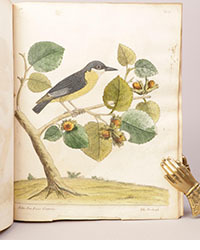
![<b>Scandinavian Art & Rare Books Auctions, Dec. 4:</b> PAUL GAIMARD: «Voyage de la Commision scientific du Nord, en Scandinavie, […]», c. 1842-46. ONLY HAND COLOURED COPY KNOWN WITH TWO ORIGINAL PAINTINGS BY BIARD. <b>Scandinavian Art & Rare Books Auctions, Dec. 4:</b> PAUL GAIMARD: «Voyage de la Commision scientific du Nord, en Scandinavie, […]», c. 1842-46. ONLY HAND COLOURED COPY KNOWN WITH TWO ORIGINAL PAINTINGS BY BIARD.](https://ae-files.s3.amazonaws.com/AdvertisementPhotos/a7c0eda0-9d8b-43ac-a504-58923308d5a4.jpg)
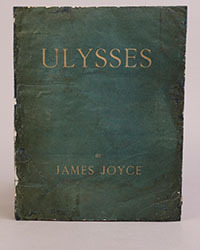
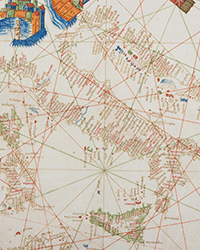
![<b>Sotheby’s, Dec. 11:</b> Darwin and Wallace. On the Tendency of Species to form Varieties..., [in:] <i>Journal of the Proceedings of the Linnean Society,</i> Vol. III, No. 9., 1858, Darwin announces the theory of natural selection. £100,000 to £150,000. <b>Sotheby’s, Dec. 11:</b> Darwin and Wallace. On the Tendency of Species to form Varieties..., [in:] <i>Journal of the Proceedings of the Linnean Society,</i> Vol. III, No. 9., 1858, Darwin announces the theory of natural selection. £100,000 to £150,000.](https://ae-files.s3.amazonaws.com/AdvertisementPhotos/00d5fd41-2542-4a80-b119-4886d4b9925f.png)

